Celebrating World Rhino Day
Assam's Role in Protecting the Greater One-Horned Rhino
World Rhino Day is celebrated annually on September 22 to raise awareness about the Rhinoceros and the urgent need for their conservation. It serves as a global platform to highlight the critical threats rhinos face, including poaching and habitat loss, while recognizing the efforts of individuals and organizations dedicated to protecting these majestic animals. The day also emphasizes the importance of preserving rhino populations for ecological balance, cultural heritage, and future generations. It is a call to unite in the fight for rhino conservation worldwide.

Asian Rhino Species: Know your Rhino!
The Indian rhino is the largest of the three Asian species and shares its single horn characteristic with the Javan rhino. The Sumatran rhino, in contrast, has two horns, a trait linking Asian and African rhinos.
Rhino Ecology: Rhinos play a crucial role in maintaining ecosystems. As mega-herbivores, they shape grasslands by grazing, creating open spaces that benefit other wildlife. Their wallowing behavior also creates waterholes, supporting various species.
Biology: Indian rhinos are known for their single horn and thick, armor-like skin. Adults can weigh up to 2,800 kg and live for 45-50 years, feeding primarily on grass, leaves, fruits, and aquatic plants.
Habitat: Rhinos thrive in floodplain grasslands, swamps, and riverine forests, particularly in the Terai region of India and Nepal.
Distribution: Indian rhinos are primarily found in protected areas in Assam, West Bengal, Uttar Pradesh, and Nepal.
The Greater One-Horned Rhino – India’s Conservation Icon
Rhinos are ancient creatures, surviving millions of years due to their size, thick skin, and distinctive horns. The greater one-horned rhino, found primarily in the Indian subcontinent, is the largest of the three Asian rhino species and a true success story in conservation. With over 70% of its population residing in Assam’s Kaziranga, this species stands as a testament to India’s commitment to wildlife preservation.
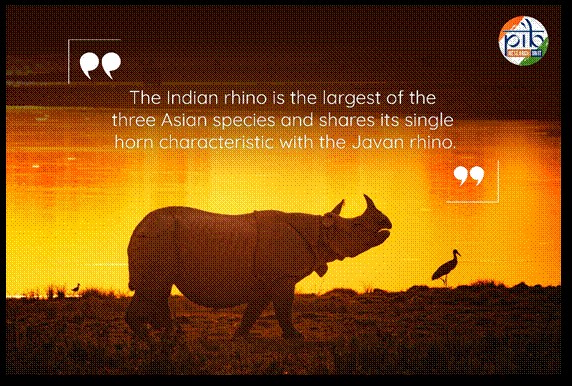
The Kaziranga Model of Conservation, which emphasizes investment in forest frontlines and scientific management of wildlife habitats, has gained global recognition. This model integrates biodiversity conservation, anti-poaching strategies, and reforestation programs, ensuring the long-term survival of rhinos.
Celebrating Assam's Rhino Conservation Efforts
Assam is collectively home to 80% of the global population of greater one-horned rhinos. This conservation success story is the result of relentless efforts by the forest department and local communities. The rhino population has surged by approximately 170% since the 1980s, growing from 1,500 to over 4,014 today.
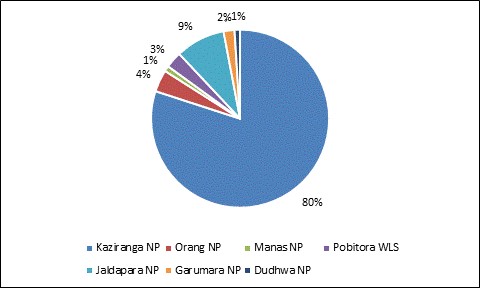
Population of Greater One Horned Rhinoceros
Assam stands at the forefront of rhino conservation in India, a position it has held for over a century through the dedication and sacrifice of its forest frontlines and the support of local communities. The state's commitment to safeguarding the iconic greater one-horned rhinoceros (Rhinoceros unicornis) has become a symbol of pride and resilience. By maintaining a rhino-centric approach, Assam continues to be a global leader in wildlife conservation. On this World Rhino Day, we honor Assam's efforts and renew our pledge to protect this majestic species for future generations.
Achievements for Rhino Conservation
Government has been working relentlessly towards Rhino conservation and the impact of these efforts is visible through achievements like:
1. Population Growth
- Rhino population growth in Assam from the 1960s (600 rhinos) to 2024 (over 4,000 rhinos).
2. Global Rhino Population in Greater Kaziranga
- 70% of the global population of this Asian Rhino species resides in Kaziranga.
3. Iconic Tourist Destination
- Kaziranga National Park gains its status as an iconic wildlife destination for both local and international tourists.
4. Prime Minister's Visit
- Prime Minister Shri Narendra Modi’s visit with forest guards (Van Durgas) during his first-ever visit to Kaziranga National Park, and his engagement in elephant rides and conservation efforts creates enthusiasm and awareness among the common folks.
5. Expansion of Rhino Habitat
- An expansion of over 200 sq km in Orang National Park and the reclaiming of 12.82 sq km in Laokhowa–Burachapori Wildlife Sanctuary, emphasizes habitat growth for rhinos.
6. New Protected Areas
- Newly declared protected areas, such as Siknajhar National Park and Poba Wildlife Sanctuary, show Assam’s commitment to securing habitats for rhinos and other wildlife.
7. Zero Tolerance to Poaching
- Historic burning of 2,479 rhino horns to symbolize Assam’s zero-tolerance policy towards poaching.
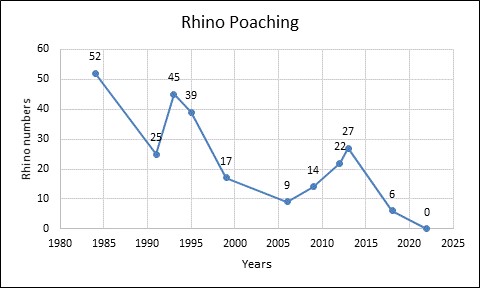
Decline In Rhino Poaching
8. Legal Measures
- A number of legal measures have been taken for Rhino protection both pre and post independence. These measures include the Assam Forest Protection Act of 1891 and the Bengal Rhinoceros Preservation Act of 1932, which prohibited the killing, injuring, or capturing of rhinos, except in self-defense or under license. After independence, the Assam Rhino Protection Act of 1954 reinforced these protections. Further, the Wildlife (Protection) Act of 1972 and its Assam amendment in 2009 increased penalties for poaching, introducing harsher sentences, including life imprisonment for repeat offenders, and higher fines to deter illegal activities. The Indian Rhino Vision 2005 program also bolstered conservation efforts.
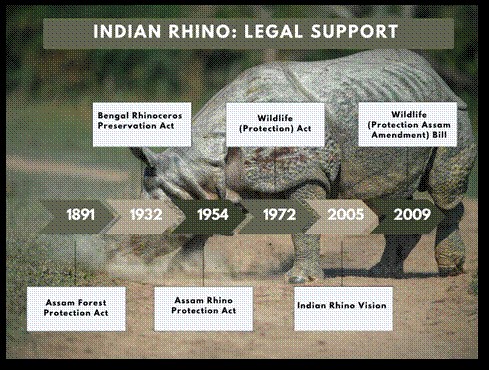
These steps help communicate Assam's achievements in rhino conservation effectively.
Kaziranga’s Success Story
Kaziranga National Park, with 2,613 rhinos as of 2022, is a global model for rhino conservation. Strict protection measures, smart patrolling, and community engagement have contributed to its success. Additionally, partnerships between the park authorities and local communities have mitigated human-wildlife conflicts, further strengthening conservation efforts.
Increase In Assam Rhino Population 1966-2022 (Based on actual census records)

Kaziranga is not only a conservation success story but also a prime destination for eco-tourism, attracting wildlife enthusiasts and photographers from around the world. Revenue from tourism is reinvested in conservation, ensuring the long-term protection of rhinos and other wildlife. Assam's Kaziranga stands as a symbol of India's leadership in wildlife conservation and coexistence with nature.
Key Threats to Rhino Conservation
Globally, rhino species face a precarious future, with populations dropping from around 500,000 in the early 20th century to just over 28,000 today. Of the five remaining rhino species, three are classified as critically endangered. Yet, the greater one-horned rhino in India has made a remarkable comeback, thanks to India's proactive conservation policies and the dedicated efforts of Assam's authorities. The main threats to Rhino population is:
Illegal Trafficking: Despite conservation successes, rhinos remain threatened by poaching, with nearly 10,000 rhinos killed in the past decade to meet the demand for their horns, prized in traditional medicine and as status symbols, particularly in China and Vietnam. Rhino products account for 29% of globally trafficked illegal wildlife goods, according to the UN Office on Drugs and Crime (UNODC).
Conservation Challenges: The recovery of rhino populations in Assam brings new challenges, including the need for expanded habitats to accommodate growing populations. Climate change poses an additional threat, with longer monsoon seasons and invasive species disrupting the grasslands that rhinos depend on. Human-wildlife conflicts are another growing concern as rhino habitats border densely populated agricultural areas.
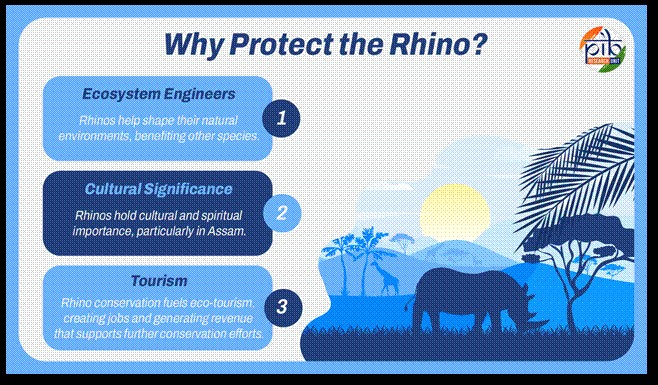
In conclusion, World Rhino Day serves as a crucial reminder of the ongoing global efforts to protect rhinos from extinction. Assam's remarkable success in conserving the greater one-horned rhino, particularly through the Kaziranga Model, stands as an inspiration in wildlife conservation. The state's commitment, alongside the support of local communities, has helped bring the rhino population back from the brink. However, ongoing challenges such as poaching, habitat loss, and climate change underscore the need for continued vigilance and cooperation. On this day, let us renew our pledge to protect rhinos and preserve their habitats for future generations.




addComments
Post a Comment